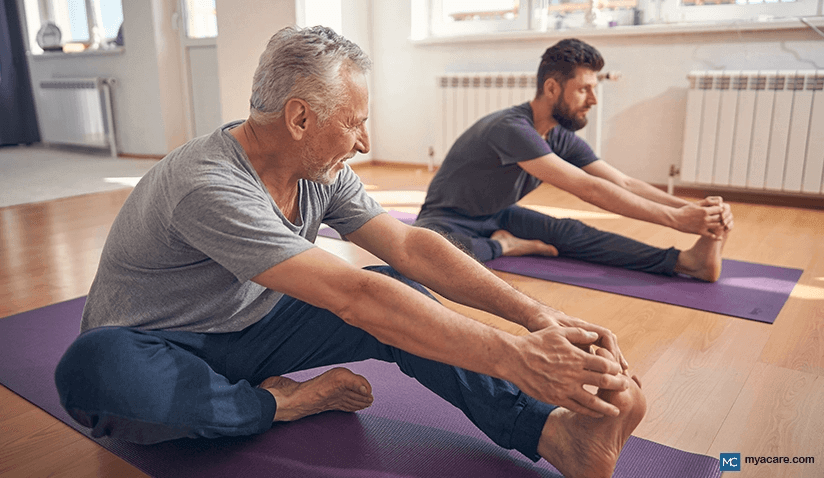How I Improved My Resilience to Injuries With Yoga

Medically Reviewed by Dr. Rae Osborn, Ph.D. - October 23, 2024
Does yoga have the potential to address the physical and psychological components of an injury? This widely asked question can open up a few avenues for debate. However, many people suffering from injuries tried to seek solace in yoga to manage pain and can vouch for its effectiveness.
Yoga has the potential to address both the physical pain and psychological impact of an injury since it places equal emphasis on the body and mind. Yoga generally increases skeletal range of motion, lengthens muscular tissue, and strengthens muscles by applying healthy stress.
Interestingly, the benefits of yoga are not just limited to addressing pains sustained due to injuries but they go all the way to help prevent injuries as well. As we go into more detail, we will explain later in this article how yoga helps prevent injuries.
As an active sportsman and fitness enthusiast, I noticed that with age, some particularly strenuous activities such as padel tennis and weight training caused more frequent minor injuries than before. While the injuries were minor, they proved to be cumbersome as it could mean reducing or stopping an activity for periods of time.
As I had explored yoga to help with my breathing concerns, I also researched the extensive benefits of yoga in preventing injury and improving balance.
Yoga is reportedly practiced by 10% of adult Americans, a figure steadily rising over the past ten years. After regularly practicing yoga for several years, my body feels more resilient; while I continue to maintain an active lifestyle, I am less injury prone and able to enjoy activities for longer and more often. Being resilient not only enables us to overcome obstacles, but also gives us the power to develop and enhance our lives.
I would like to share my experience with yoga and how it has helped prevent injuries. If you plan to incorporate this routine for building resilience, please always consult your doctor for any medical concerns.
How Can Yoga Reduce Injury Risk and Recovery Time?
Before I began my yoga journey, injuries from pulled muscles were common for me from playing sports and other strenuous activities. Since learning yoga, I spend more time preparing for any physical activity, making sure to do at least 15 mins of yoga breathing and stretches beforehand. This helps me prevent injury during the activity and recover faster when I do get injured. In addition, yoga helps me feel more mentally connected and alert to my body, contributing to a lower risk of injury.
Working with a yoga teacher is always helpful. Additionally moving too fast or incorrectly performing yoga postures can do more harm than good, leading to the very injuries you are looking to avoid. A teacher can help guide you to ensure correct form and prevent injuries.
Regularly practicing yoga helps prevent injuries as well:
- Increased Flexibility and Range of Motion
According to several research studies, regularly practicing yoga improves flexibility and balance.[1] Yogic postures combined with breathing techniques were found to be most effective in enhancing the range of motion of the muscles in the lower back and the hamstring. Yoga has also been shown to relieve muscular tension. Thus, through active and passive stretching exercises that increase flexibility and mobility, yoga can help minimize injuries.
- Muscle Strength and Improved Endurance
Improved flexibility is simply one aspect of yoga. According to studies, besides flexibility, yoga also considerably increases physical strength. Regular yoga practice strengthens your muscles and spine and promotes bone health. As a result, your tendons and ligaments also become stronger, reducing the likelihood of injury. For people prone to inflexibility or joint instability, focusing on strength-building during yoga can be particularly crucial to preventing hyperextension and additional damage. Certain poses can also help stabilize your joints.
Yoga can also build endurance. For instance, better breathing enhances oxygen supply to the working muscles, which helps improve endurance and recovery. In addition to respiratory health, yoga enhances blood circulation, efficient energy utilization, and mental toughness, promoting endurance and minimizing injury risks.
- Restores Body Symmetry
Of the many advantages of regular yoga practice, better posture and rectifying muscular imbalances are vital. Excessive dependence on your dominant side and the resultant unstable utilization of tissues and muscles is the root cause of many overuse ailments, including swimmer's shoulder, carpal tunnel syndrome, and runner’s knee. While the human body is not built symmetrically, it can benefit from being treated with more balance. Therefore, a yoga routine that emphasizes good alignment while incorporating a balanced amount of stretching and strengthening can be beneficial.
- Improved Balance
One of the most significant benefits of yoga is promoting overall body balance. Proprioception refers to the body's ability to perceive movement, action, position, and make anticipatory adjustments. Consistent yoga practice involving switching between multiple poses plays a significant role in building your body balance and proprioception, which are essential to prevent falls and injuries.
Limited research confirms my personal experience:
It reduces muscle tension. Workers who practiced yoga in the workplace were shown to have lower stress levels and carry less tension in their bodies. For instance, stretching increases the range of motion, circulates blood and oxygen, and feeds tissues with nutrients. This helped to reduce the risk of injuries on the job.[2]
Lessens Fatigue. Exhaustion and fatigue are known to increase the risk of injuries, whether at work or during physical activity. Numerous studies highlight how yoga can help to lessen fatigue in patients with various exhausting health conditions, including chronic fatigue syndrome[3], cancer, fibromyalgia and asthma[4]. Yoga is a powerful remedy for exhaustion because it amalgamates movement, rest and stress reduction with the cultivation of prana (life force energy) while activating the parasympathetic nervous system and improves balance and stability. Women with musculoskeletal problems experienced improved balance and a better ability to walk after engaging in yogic exercises[5].
Decreases Recovery Time Post Surgery. In one small study, practicing yoga proved to reduce the hospital stay of women who had breast surgery.[6] Compared to women who did not practice yoga, the yoga group also required less time until their stitches were removed, indicating that yoga may have sped up the wound healing process.
Conclusion
To sum up, regular yoga practice incorporating various poses and breathing techniques has been shown to improve balance, flexibility, and endurance, aiding in preventing injuries. [7] However, consulting a yoga teacher who can guide you on the right path is crucial since doing yoga the wrong way can bring more harm than good.
To search for the best doctors and healthcare providers worldwide, please use the Mya Care search engine.
Manish Menda is one of the Co-Founders of Mya Care. He has a Bachelor of Business Administration from Washington University in St. Louis and a Master of Business Administration from Saïd Business School, University of Oxford. Manish is an avid entrepreneur and pioneered patient financing in India. Manish and his family founded Mya Care with the intention to empower patients and give them the tools they need to find health and wellness services for their specific needs around the world. Manish leads an active lifestyle, and his hobbies include cycling, hiking, padel tennis, swimming, weight training and yoga.

Dr. Rae Osborn has a Ph.D. in Biology from the University of Texas at Arlington. She was a tenured Associate Professor of Biology at Northwestern State University, where she taught many courses to Pre-nursing and Pre-medical students. She has written extensively on medical conditions and healthy lifestyle topics, including nutrition. She is from South Africa but lived and taught in the United States for 18 years.
Sources:
Featured Blogs



